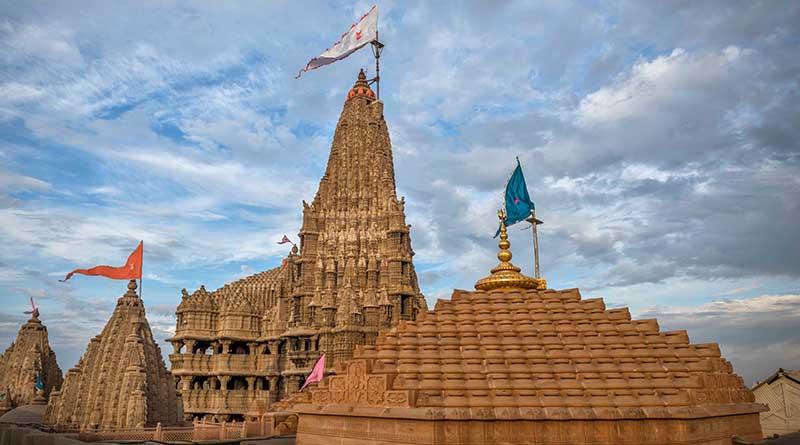Nestled in the western coastal region of India, Dwarka Dham (also known as Dwaraka Dham) is one of the most sacred and historically rich pilgrimage sites in Hinduism. Located in the state of Gujarat, Dwarka is believed to be the ancient city where Lord Krishna ruled as the king and where he spent a significant part of his life. Dwarka is one of the Char Dham pilgrimage sites, making it a vital destination for millions of Hindus seeking divine blessings and spiritual solace.
The Dwarka Dham Temple stands as a testament to the greatness of Lord Krishna and is an essential part of the religious and cultural heritage of India. This blog will guide you through the spiritual significance, historical importance, and the divine experiences that await you at the Dwarka Dham Temple.
1. Historical and Mythological Significance of Dwarka Dham
The city of Dwarka is not just a religious center but also a city steeped in ancient mythology and history. According to Hindu scriptures, Dwarka is said to be the kingdom of Lord Krishna, who is believed to have established the city after leaving Mathura to protect his people from evil forces.
- Mahabharata Connection: Dwarka finds a prominent place in the Mahabharata, the ancient Indian epic. Lord Krishna’s role in the epic, particularly his involvement in the Kurukshetra war and his guidance to Arjuna through the Bhagavad Gita, makes Dwarka a significant pilgrimage site. The city is believed to have been submerged into the sea after Lord Krishna’s departure from Earth, marking the end of the Dwapara Yuga.
- The Legend of the City: According to Hindu mythology, Dwarka was originally built by Lord Vishwakarma, the divine architect, on the instructions of Lord Krishna. The city was constructed with gold and precious gems and is described as a marvelous and prosperous kingdom. Today, the ruins of Dwarka and its temples are testament to its historical and spiritual significance.
Dwarka is often referred to as “Jagat Mandir” (the temple of the world), which signifies the temple’s importance not just to the region but to the entire universe. The city of Dwarka is also called the “Moksha Dham” because it is believed to be one of the places where attaining liberation (moksha) is possible through devotion.
2. Dwarka Dham Temple: Architecture and Features
The Dwarka Dham Temple, also known as the Dwarkadhish Temple, is a magnificent structure dedicated to Lord Krishna. The temple’s architecture and design reflect the ancient grandeur of the city and the divine presence of Lord Krishna.
- Temple Structure: The temple is built in traditional Maru-Gurjara style of architecture, which is prominent in Gujarat. The structure includes intricately carved pillars, high spires, and elaborate statues that depict Lord Krishna in various forms.
- Main Shrine: The primary deity in the Dwarka Dham Temple is Dwarkadhish, a form of Lord Krishna. The idol of Lord Krishna is made of black stone and is said to be more than 5,000 years old. The idol is positioned in a standing posture with a flute in one hand and a conch in the other. Devotees often visit the temple to seek Lord Krishna’s blessings for peace, prosperity, and spiritual enlightenment.
- The 5-Storey Temple: The temple is built on a 5-story structure, with each level providing a beautiful view of the surrounding landscape. The temple is supported by 72 pillars, symbolizing the unity of the universe. The temple’s main spire reaches a height of around 170 feet, and the structure is said to be visible from miles away.
- Sacred Artifacts: Inside the temple, you will find various sacred items, including the Sudharshan Chakra (Lord Krishna’s divine weapon) and numerous idols depicting scenes from Lord Krishna’s life, such as his birth, his youth, and his role as a protector.
3. The Pilgrimage Experience: Darshan at Dwarka Dham Temple
Visiting the Dwarka Dham Temple is a spiritually fulfilling experience that offers peace, serenity, and a deep connection with Lord Krishna. Here’s what you can expect during your visit:
- Darshan (Divine Sight): The moment you step into the Dwarka Dham Temple, the sacred vibrations of Lord Krishna’s divine presence fill the air. Devotees gather in large numbers to witness the early morning rituals, including the Mangala Aarti, which is performed in the early hours of the day. The temple opens its gates early, and devotees throng the temple to get a glimpse of the deity, chant the name of Krishna, and offer their prayers.
- The Evening Aarti: The evening Aarti, known as Shayan Aarti, is another spiritually significant event at the temple. The temple comes alive with the ringing of bells and the chants of “Hare Krishna Hare Rama,” creating a mesmerizing atmosphere that is believed to bring one closer to the divine.
- Holy Bath at the Gomti River: The Gomti River, flowing near the Dwarka Temple, holds immense significance. It is believed that taking a holy dip in the river washes away sins and brings peace and prosperity. Devotees take the sacred bath before entering the temple for Darshan.
4. Nearby Attractions and Pilgrimage Sites
In addition to the Dwarka Dham Temple, several other sacred sites surround the city, making it a perfect destination for a spiritual retreat.
- Bet Dwarka: Located on an island in the Arabian Sea, Bet Dwarka is believed to be the place where Lord Krishna spent time with his family and friends. A short boat ride from the mainland takes you to this peaceful and beautiful place. The Bet Dwarka Temple houses a statue of Lord Krishna and is considered one of the most significant places for devotees visiting Dwarka.
- Nageshwar Jyotirlinga: Located about 17 km from Dwarka, this is one of the 12 Jyotirlingas dedicated to Lord Shiva. It is considered a highly auspicious place to visit for devotees of Lord Shiva.
- Rukmini Temple: The Rukmini Temple is dedicated to Rukmini, Lord Krishna’s queen. It is located a few kilometers from the Dwarka Dham Temple and is known for its beautiful architecture and intricate carvings.
- Dwarka Beach: After visiting the temples, a peaceful stroll along the Dwarka Beach provides a serene experience. The beach offers panoramic views of the Arabian Sea and is a great place for relaxation.
5. Dwarka Dham Temple Tour Packages
For those planning to visit Dwarka, several tour packages are available that include transport, accommodation, and guided tours of the temple and surrounding areas. These packages are designed to cater to different needs, from budget-friendly options to luxury tours. Some of the popular Dwarka Dham Temple Tour Packages include:
- Dwarka-Girnar-Patan Tour Package: This package covers the major temples in Dwarka, including Dwarka Dham Temple, Nageshwar Temple, and Rukmini Temple. It also includes a visit to Girnar, an important pilgrimage site for Jains and Hindus.
- Dwarka-Rajkot Tour Package: This package takes you to Dwarka and then to Rajkot, a city known for its cultural heritage and proximity to the ancient Baba Ramdev Temple.
- Dwarka & Somnath Tour Package: A popular choice for pilgrims, this package combines a visit to Dwarka with the sacred Somnath Temple, one of the twelve Jyotirlingas of Lord Shiva.
- Family & Group Pilgrimage Packages: Special packages are available for families and groups, offering personalized itineraries and transportation options.
6. Best Time to Visit Dwarka
The best time to visit Dwarka is between October and March, during the cooler months. The weather is pleasant, making it ideal for sightseeing and temple visits. Avoid the monsoon season (June to September) due to heavy rainfall and possible flooding in some areas.



Hi, this is a comment.
To get started with moderating, editing, and deleting comments, please visit the Comments screen in the dashboard.
Commenter avatars come from Gravatar.